Climate-Resilient Agriculture as a Force Multiplier for Climate and Development Goals
As the international community ramps up climate adaptation and mitigation, investing in climate-resilient agriculture can reduce poverty, improve food security and nutrition, and strengthen ecosystems.
An issue brief by FP Analytics, produced with support from Catholic Relief Services
July 2024
Worsening climate change is threatening lives, livelihoods, and ecosystems worldwide, with socioeconomic impacts most pronounced across low- and middle-income countries. Yet, estimated emissions-reduction efforts are falling well below the level necessary to be consistent with the Paris Agreement’s goal of limiting warming to 1.5°C above pre-industrial levels. Higher temperatures, shifting rainfall patterns, and extreme weather events are no longer just plausible future events, but current manifestations of climate change, with major disruptions to agriculture, forestry, other land use, and fisheries (AFOLU) systems that underpin the safety and well-being of global populations. Wide-reaching climate impacts are exacerbating food insecurity, which affected 282 million people across 59 countries in 2023, and pushing the global goal to end hunger by 2030 out of reach. Indeed, multiple regions across the globe are projected to face double-digit declines in agricultural productivity by 2050, endangering nutrition. Low-income countries, despite contributing little to global greenhouse gas (GHG) emissions, are the most vulnerable to these changes, as climate change puts vulnerable populations at risk of malnutrition, economic stagnation, forced migration, health crises, and even conflict. Amid these intersecting crises, climate-resilient agriculture represents an underutilized but promising pathway for accelerating progress on climate, sustainability, and development goals.
.
Globally, food systems are responsible for as much as one-third of man-made GHG emissions, and yet less than 4 percent of annual climate finance commitments specifically target AFOLU systems. Underinvestment in climate-resilient agriculture, both financially and politically, represents a major missed opportunity to undertake low-cost, high-impact actions to mitigate climate change and make progress on headline development goals. Climate-resilient AFOLU practices have the potential to significantly reduce GHG emissions from the sector—by as much as between 40 and 70 percent. But importantly, they can also enable simultaneous progress on multiple UN Sustainable Development Goals (SDGs). A dollar spent on climate-resilient agriculture can yield direct benefits related to ending hunger (SDG 2), improving water management (SDG 6), or encouraging responsible stewardship of terrestrial ecosystems (SDG 15). That same dollar investment can also drive progress on other interrelated goals, such as ending poverty (SDG 1), improving health care (SDG 3), and achieving gender equality (SDG 5).
This brief examines climate-resilient agriculture as a conduit to deliver effective action against climate change in the agricultural realm and beyond. It highlights illustrative examples—examining soil and water management and the integration of farmer-level perspectives with territorial and landscape-wide systems—to showcase key requirements to maximize the impact of such interventions. It also addresses the expansive funding gap between current spending in the field and anticipated need. Seizing the changemaking potential of climate-resilient agriculture requires renewed attention from governments, multilateral and development institutions, and the private sector. It also requires acknowledging that these approaches will form an indispensable part of any effort to comprehensively address climate change and achieve interrelated development goals to strengthen communities and ecosystems. These lessons are especially pertinent in the lead-up to COP29 in Baku, Azerbaijan, where a key area of focus will be climate finance and at which greater emphasis needs to be placed on support for climate-resilient agriculture.
Climate-resilient agriculture can effectively mitigate the intensifying impacts of climate change.
Agricultural communities, particularly in low- and lower-middle-income countries, are already bearing the brunt of climate change. For example, Southeast Asia is at risk of losing as much as 50 percent of its crop production by the year 2100 due to rising temperatures, while sub-Saharan Africa could see agricultural yields fall by between 5 and 17 percent by 2050. Some 2 billion people who rely on certain grains and legumes for their diets are at higher risk of zinc and iron deficiencies as the concentration of CO2 in the atmosphere increases. If these trends are left unchecked, the consequences for food security, nutrition, and economic development, both regionally and globally, will be severe.
Climate-resilient agricultural practices offer a productive pathway to address these concerns, because they help to reduce emissions in an emissions-intensive sector while enhancing the resiliency of affected communities to natural and manmade shocks. Climate-resilient agriculture traditionally involves long-established agricultural practices such as crop rotation, agroforestry, and conservation agriculture. But innovative new techniques, such as precision agriculture, smart irrigation systems, and no-till agriculture, can also yield far-reaching benefits. Together, these approaches have the potential to drastically reduce the vast emissions footprint of human agricultural activity, all while enabling progress toward a range of sustainable development goals.
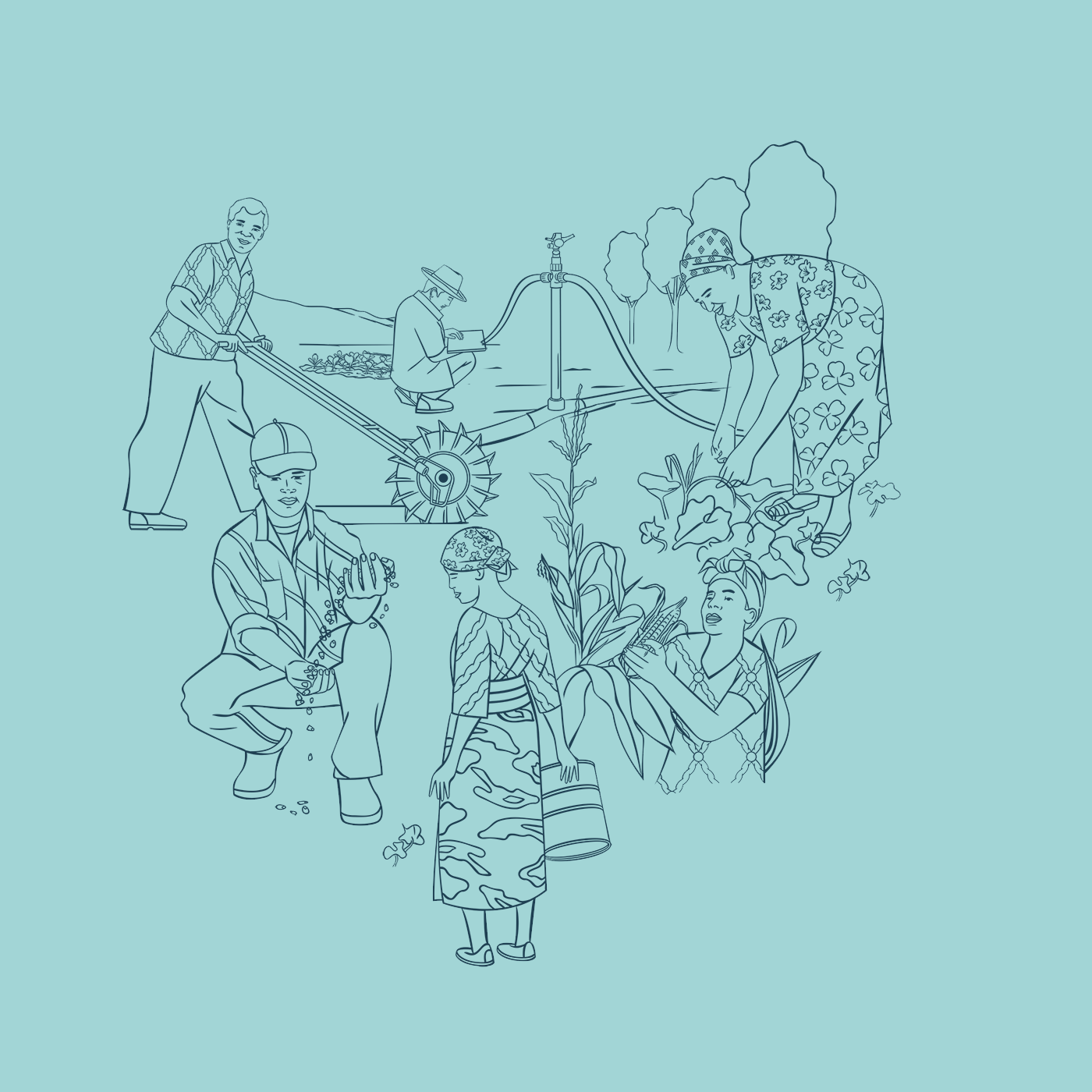
FIGURE 1
Leveraging Climate-Resilient Agriculture across the Crop Life-Cycle
Climate-resilient agriculture can be deployed across the crop life-cycle to deliver varied, compounding benefits.
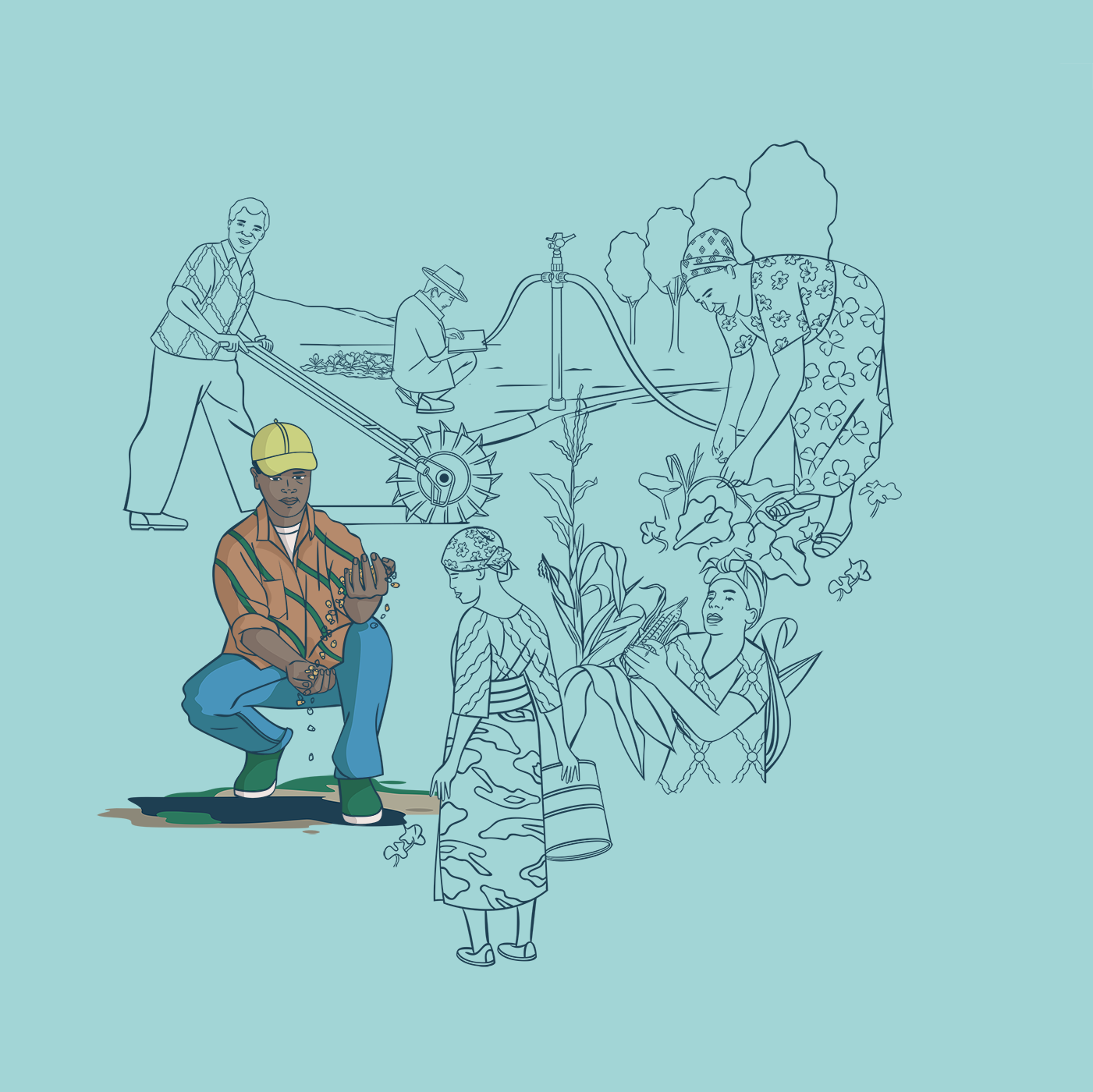
Seed Selection
Seed varieties can be optinized based on local conditions and anticipated climatic patterns.
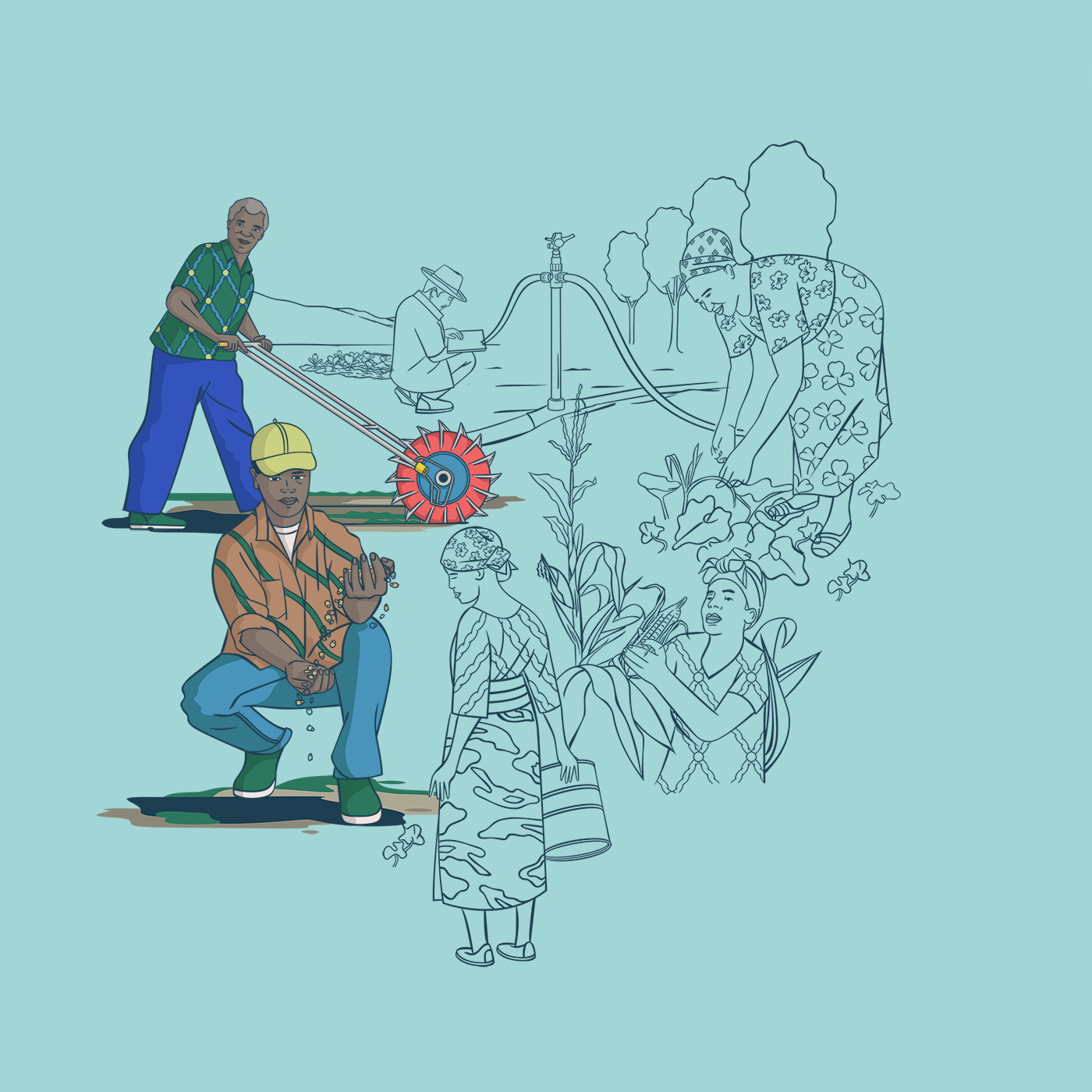
Land Preparation
Cover cropping and conservation tillage can be used to improve soil health, prevent erosion, and retain moisture.

Planting
Climate forecasting can be used to help predict optimal planting times to avoid adverse weather events and ensure higher survivability.
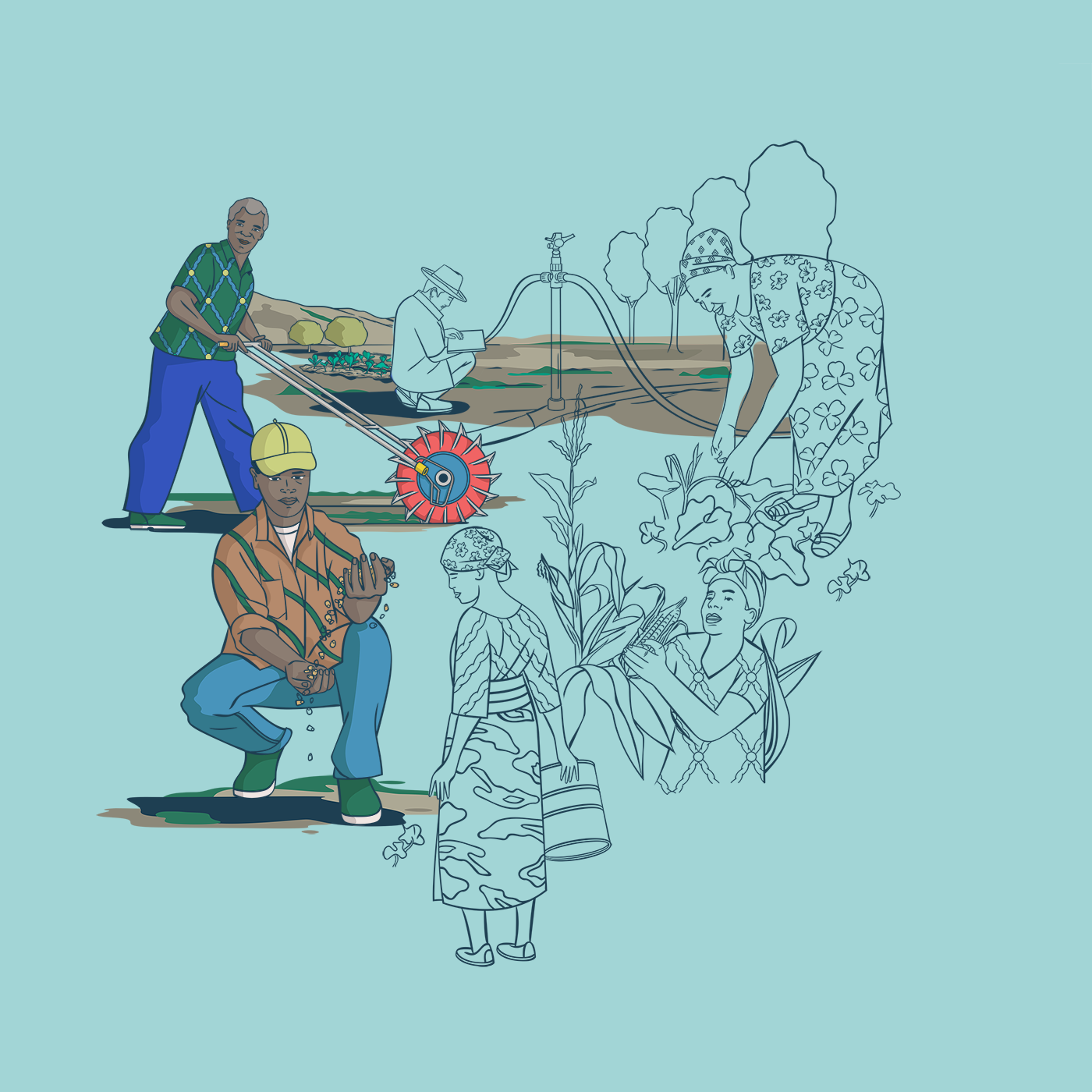
Germination and Early Growth
Mulching techniques can be applied to retain soil moisture and regulate soil temperature, improving crop health and saving water.
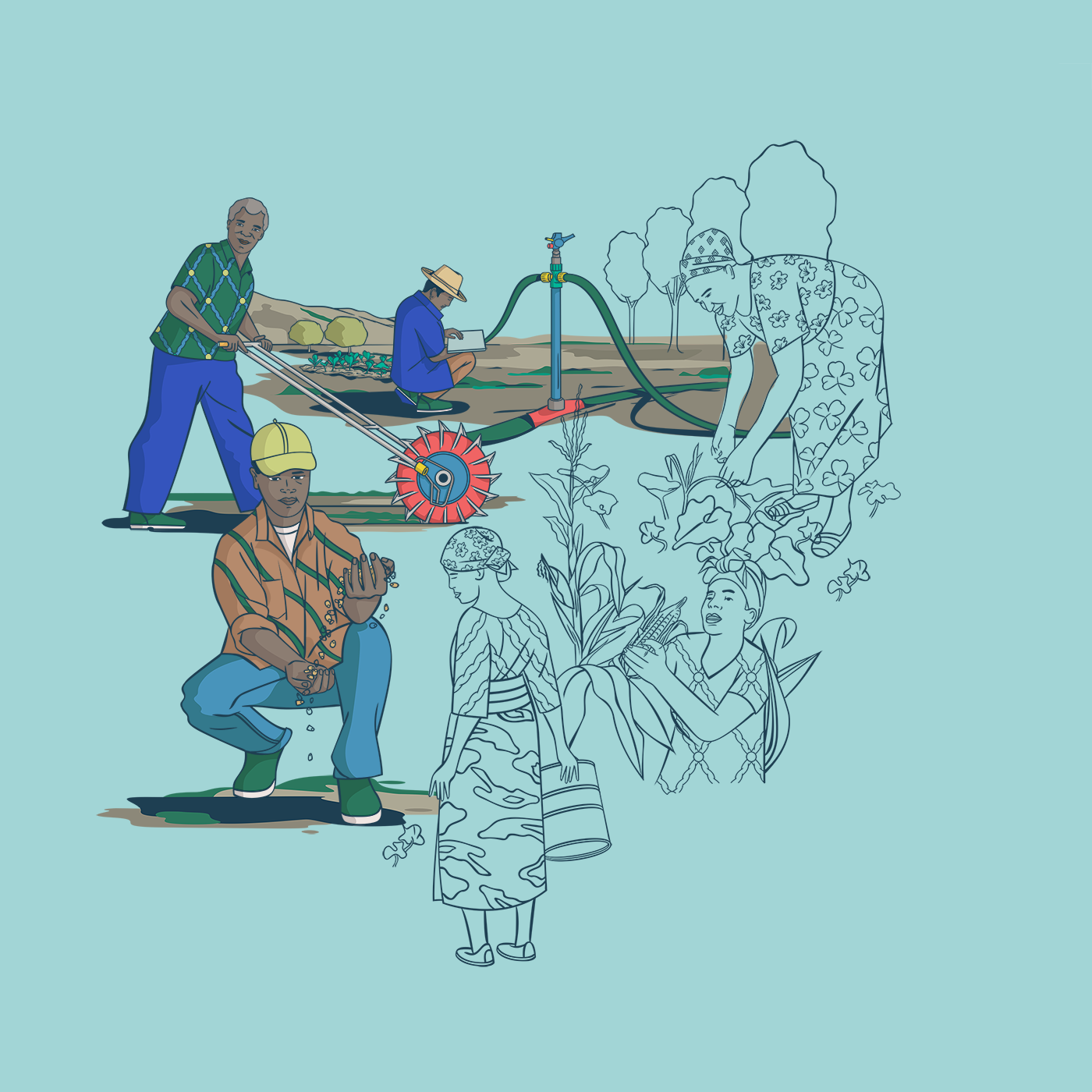
Vegetative Growth
Water management techniques, including soil moisture monitoring technologies, can be applied across seasons to reduce water consumption and waste.
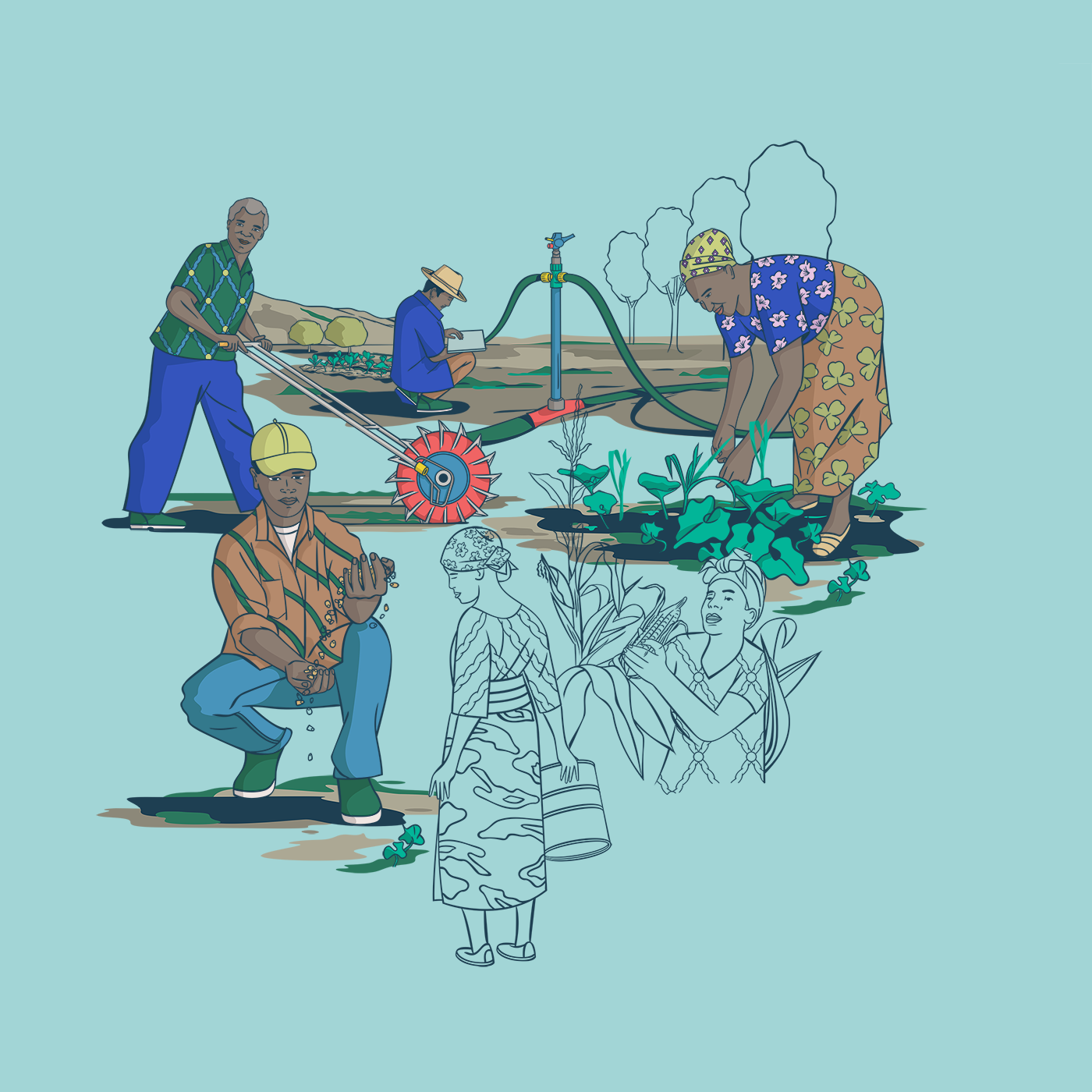
Flowering
Crops can be paired with flowering plants that support pollinators, which deliver a host of benefits, including enhancing crop yield and biodiversity, improving ecosystem resilience, and aiding natural pest management.

Fruiting and Maturation
The use of agroforestry practices can help protect fruiting crops, such as by reducing stress due to heat or protecting against wind damage.
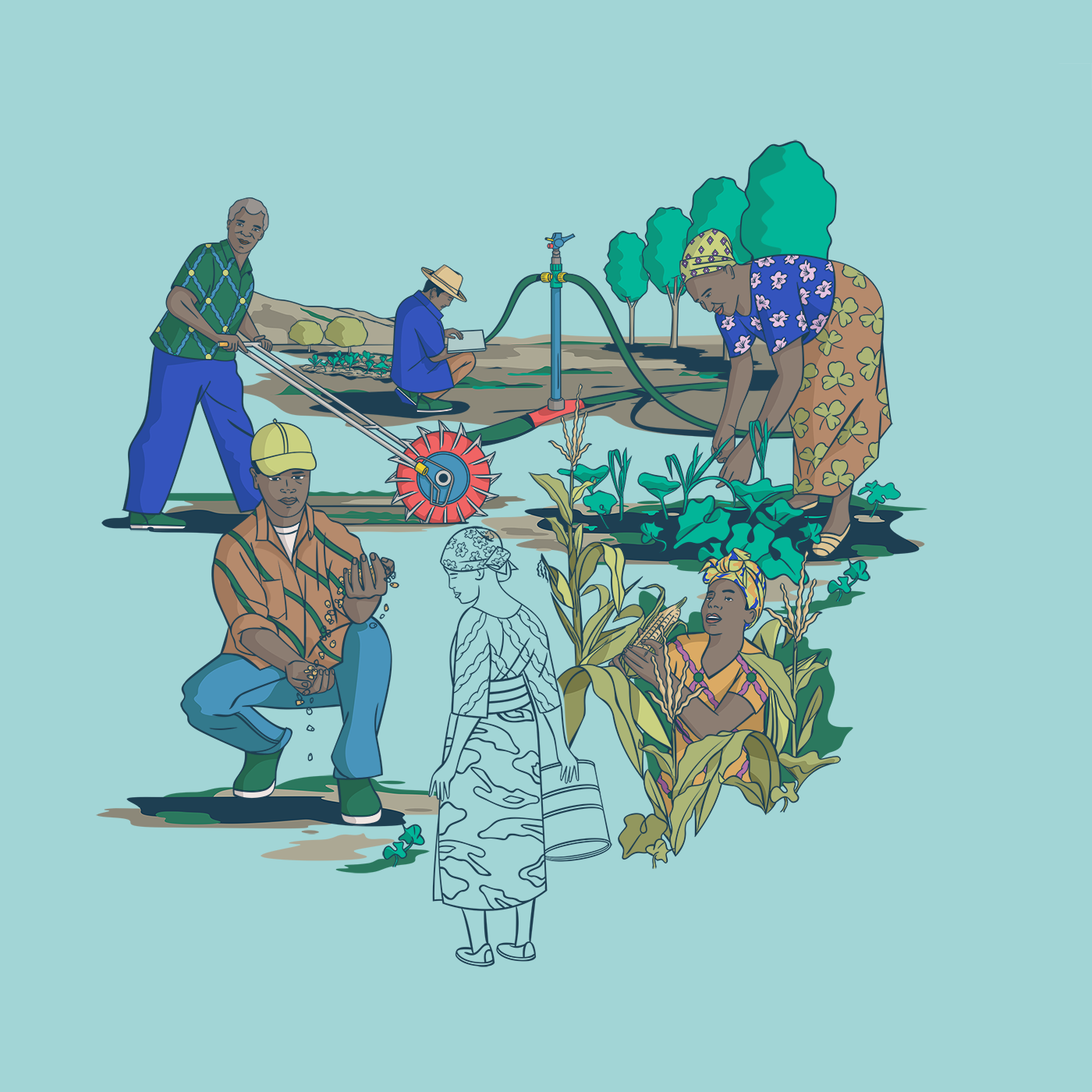
Harvesting
Minimizing soil disturbance and applying crop residue management can protect soil halth and minimize erosion.

Off-Season
Crop rotation can be diversified to enhance soil health, optimize nutrient use, and manage pests and disease.
There are widespread examples of how climate-resilient agriculture increases agricultural productivity, reduces vulnerability to climate and economic pressures, and lowers climate impact. Such projects generally combine multiple approaches concurrently to maximize positive benefits and harness relationships between natural systems. For example, the Wellness and Agriculture for Life Advancement (WALA) project, implemented by a group of eight NGOs from 2009 through 2014 in 32 watersheds in southern Malawi, demonstrates the value of combining soil and water conservation structures with strategies to recycle plant nutrients and combat erosion, ultimately leading to a 63 percent increase in maize crop yields. Improved water management similarly led to greater resilience to moderate drought, helping to avoid crop losses and maintain food security. Across the Dry Corridor, a region of dry tropical forest in El Salvador, Guatemala, Honduras, and Nicaragua, the Quesungual Slash-and Mulch Agroforestry System is being used to replace slash-and-burn practices and encourage farmers to retain trees, use pruning methods, and maintain ground cover. Based on the project’s estimates, these practices are increasing yields by as much as 50 percent, improving humidity levels by up to 20 percent, and diversifying income streams for farmers by retaining access to wood and fruit products that can be sold.
Other projects demonstrate the potential climate impact of agricultural interventions to substantially address GHG emissions. Abating GHG emissions per kilogram by as much as 60 percent, the System of Rice Intensification is a management system deployed in Cambodia, India, Mali, and Vietnam that focuses on four key components—seed selection, optimized spacing, fertile soil, and minimal water. In addition to its GHG mitigation potential, farmers favor the technique because it reduces costs for seeds, fertilizer, and irrigation, leading to higher incomes. While interventions like this showcase the varied impacts of climate-resilient agriculture, they also highlight lessons and best practices that policymakers, international and local civil society organizations, and the private sector can draw on to optimize the community-level impacts of climate-resilient agricultural practices.
Maximizing the positive impact of climate-resilient agriculture requires harnessing key relationships within and among natural and human systems.
Implementing climate-resilient agriculture at scale will require accounting for complex relationships between soil health and water management, between people and agriculture, and across wider manmade and natural systems. For example, soil health is increasingly recognized as the indispensable foundation upon which productive, sustainable agriculture rests for both crops and livestock, with the value of soil biodiversity alone estimated at USD 1.5–13 trillion annually. But this value is also inextricably linked with water systems. Healthy soil improves water retention, which helps reduce erosion, mitigate water runoff, and improve water conservation, generating a mutually beneficial feedback loop whereby climate-smart water- and soil-health practices reinforce one another. Projects like the Africa RISING program capitalize on this relationship by demonstrating how integrated soil and water management practices can yield simultaneous benefits. Their work in Tanzania led to an 11 percent drop in soil erosion, a 1.08 tons-per-hectare increase in average ground nut production, and a reduction of local annual food shortages by an average of 0.8 months.
Effective climate-resilient agriculture similarly depends on prioritizing people-centered approaches that are context-sensitive and attuned to the needs and aspirations of individuals, their communities, and their relationships to the natural world. This requires accounting for the interplay among a myriad of socioeconomic, political, and biophysical characteristics. For example, a review published in Nature Plants found that 107 of 202 studies on the use of climate-resilient seed varieties mentioned that characteristics like gender, age, marital status, and ethnicity impacted farmers’ seed choices in low- and middle-income countries. Women represent approximately 43 percent of the global agricultural workforce, rising to 60 percent or more in lower and lower-middle income countries across the global south, where they comprise the majority of smallholder farmers. Yet, women farmers generally own fewer assets, such as land and livestock, and have less access to training, insurance, finance, and key agricultural inputs, such as seeds and fertilizer. Smallholder farmers, including women who remain underrepresented in decision-making processes, have the experiential knowledge, awareness, and social trust needed to right-size agricultural practices to local contexts.
From project design, to implementation, to monitoring and evaluation, stakeholder input from farmers, their communities, and adjacent industries and systems is critical to the success of any individual project, but also to generating sustained commitment to climate-smart practices on a wider scale. Projects like CGIAR’s Climate-Smart Villages recognize this, empowering individual villages to select and pursue the practices and innovations that feel right to them and to the context in which they live and work. This work typifies territorial and landscape approaches to agricultural interventions, which ensure that all relevant stakeholders are accounted for and enjoy ownership in climate action while maximizing system-wide impact. Territorial approaches involve accounting for region-specific characteristics that may impact project design and implementation, including by seeking input at the national and subnational levels from urban, rural, and regional actors. Likewise, landscape approaches seek to elevate cross-sectoral and cross-ecosystem considerations to ensure that interventions deliver maximum positive impact across sectors. Both approaches seek to balance agro-environmental and socioeconomic considerations, provide a platform to facilitate collective community action against climate change, and ensure that the perspectives of small-scale farmers and wider communities are accounted for simultaneously.
Importantly, agricultural interventions do not exist in a silo—they are intimately connected to, and impacted by, interrelated development goals and the multifarious impacts of climate change. In 2023, an estimated 691 million people were living on less than USD 2.15 per day, with rising temperatures and inclement weather events applying extra pressure to communities’ economic security. For example, a 1°C increase in temperature is projected to yield a 9.1 percent increase in global poverty. Similarly, 2.33 billion people suffered from moderate or severe food insecurity in 2023, and progress toward ensuring access to adequate food for everyone by 2030 (SDG 2) has stalled, partially due to the impacts of climate change. As these pressures intensify and compound year on year, they result in growing costs for agricultural communities that can put climate change intervention efforts at risk.
These interlinked development issues can form positive or negative feedback loops that impact the effectiveness of climate-resilient agricultural practices from the household level to landscape-wide. Secure, prosperous, and healthy communities can devote resources to climate action, including through agriculture, while those same practices can improve a community’s climate resilience, economic output, and public health. Conversely, a deteriorating climate exacerbates insecurity, poverty, and threats to health and well-being, making it more difficult for societies to implement and prioritize climate-oriented interventions. This mutually reinforcing relationship makes clear the imperative for a holistic approach to climate change mitigation and adaptation efforts that breaks down silos and engages with attendant development issues simultaneously. Disaster recovery and reconstruction efforts can be tailored to incorporate climate resilience principles, thereby hardening communities to future disasters while meeting immediate needs. For example, the Food and Agriculture Organization (FAO) implemented emergency response and recovery programming in the Philippines in 2013 following Typhoon Haiyan with the intention to not just return communities to the status quo but also to implement climate-resilient agriculture interventions, restoring livelihoods and improving resilience against future disasters.
To realize the full potential of climate action in agriculture and food systems, significant increases in financial and technical support are required globally.
The full potential of climate action in agriculture and food systems will be stymied without significant increases in financial resources. The AFOLU sector is a considerable driver of climate change, accounting for between 13 and 21 percent of all annual GHG emissions. The AFOLU sector also has the largest annual mitigation potential through 2030 of any sector, estimated at 14.5 gigatons of CO2 equivalent—more than energy, industry, or transportation. However, the AFOLU sector was the recipient of just 3.4 percent of the USD 1.3 trillion in climate finance mobilized in 2021 and 2022. The Climate Policy Initiative estimates that global climate finance needs to top USD 10 trillion annually from 2031 to 2050 to keep global warming below the 1.5°C goal, and proportionally the largest growth in funding needs to happen in AFOLU, where financing needs to increase by nearly 180 times for interventions to meet their full potential. The funding gap is especially stark for small-scale agrifood systems, which received just 0.2 percent of global mitigation finance in 2019 and 2020, even though small-scale farmers cultivating two hectares or less produce 35 percent of the world’s food and 5 percent of global GHG emissions.
FIGURE 2
Closing the Climate Finance Gap Underlying Climate-Resilient Agriculture
Despite accounting for as much as a third of annual GHG emissions, the proportion of climate finance directed toward adaptation and mitigation in the agricultural sector and across broader food systems is just a fraction of total anticipated need.
Sources:Climate Policy Initiative, Climate Policy Initiative, Nature, Intergovernmental Panel on Climate Change
Amid this financing shortfall, there is a strong economic case to be made for climate-resilient agriculture as a cost-effective, catalytic route to mitigate climate change and lower emissions while supporting human development. A wide variety of projects demonstrate compelling benefit-cost ratios (BCRs), where each dollar spent more than pays for itself in anticipated benefits. For example, research suggests that investments in general regenerative agriculture practices, which focus on soil health, have a BCR of 2–5:1, while investments in water resilience projects in emerging economies can have a BCR as high as 50:1. A water-smart agriculture project by Catholic Relief Services in Mesoamerica that reached more than 3,000 farmers exemplifies this kind of BCR. The five-year project delivered an estimated return on investment of USD 2.46 for every dollar spent by combating land degradation, improving water security and productivity, and raising incomes—including an estimated USD 7.70 in economic value per hectare, thanks to added carbon sequestration, enhanced water storage, and improved soil nutrients. Importantly, estimates like these likely fail to capture the full scope of indirect benefits from climate-resilient agriculture. Higher income due to increased agricultural productivity, for example, can increase household savings and therefore access to health care, while agroecology programs can increase knowledge sharing and the social capital of farmers. In this sense, projects like these can deliver progress that extends far beyond agriculture.
FIGURE 3
Returns on Investment in Climate-Smart Agriculture
Investments in climate-resilient projects hold the potential to generate outsized impact in terms of anticipated benefits for every dollar spent. These include easy-to-measure benefits such as improvements in crop yield and reduced damage from adverse weather events, but also harder-to-measure benefits such as improvements to health and nutrition and improved ecosystem health.
Sources: Cogent Economics & Finance, Catholic Relief Services, BCG, GIZ, World Bank
It will take collective mobilization to close this gap, but multilateral development banks (MDBs) and the private sector both have particularly important roles to play. As MDBs pursue reform to more closely align their activities with global needs, maximize impact, and increase capital, they also need to take advantage of the high potential—in terms of development progress and return on investment—that agriculture holds. Closer coordination, sharing of best practices, and investments in data collection can help ensure that MDBs are working with one another and their global partners to maximize impact in this field—and expanding their climate-finance contributions to low-income countries, estimated at USD 66 billion in 2022. At the same time, the private sector has a crucial role to play by investing in markets for climate-smart agricultural products; encouraging research and development to advance nutrition, supply, and reach; and making more credit available to farmers globally. Efforts to de-risk climate finance—such as co-financing, guarantees, and blended finance—can help to drive private capital to climate-resilient agriculture and adjacent climate adaptation measures.
Climate-resilient agriculture can act as a potent force multiplier for addressing climate and development challenges.
As the global community expands efforts to address climate change, countries cannot afford to forego or underinvest in climate-resilient agriculture. It represents a potent route through which to make low-cost, high-impact progress simultaneously on key climate and development goals. These objectives include lowering GHG emissions, protecting biodiversity, and making communities more resilient to a changing climate, but also addressing poverty, ending hunger, and decreasing forced migration. A dollar spent on agroforestry can simultaneously safeguard against erosion and extreme weather events, enhance ecosystem services, and diversify farmer income streams, while better-managed water systems can alleviate droughts, improve crop yields, and protect community health. However, as the Intergovernmental Panel on Climate Change acknowledges, the significant near-term mitigation potential in AFOLU systems “cannot compensate for delayed emission reductions in other sectors.” The AFOLU sector is one of several central pillars that underly a multi-pronged global response to a changing climate. For policymakers, donors, and development partners, the AFOLU sector is attractive due to its immense short-term emissions-reduction potential as well as the direct, tangible benefits it can yield to farming communities, who are among the groups most adversely impacted by climate change while being on the frontlines of adaptation and mitigation efforts.
Yet, climate-resilient agriculture efforts remain severely underfunded, requiring increased political and financial backing, accountability, and technical support and innovation. Actions like the COP28 Declaration on Sustainable Agriculture, Resilient Food Systems, and Climate Action show good intent—for example, by demanding the integration of agricultural and food systems considerations into National Adaptation Plans and Nationally Determined Contributions (NDCs) by the time of the COP30 summit. But every opportunity to build and sustain progress on climate-resilient agriculture needs to be pursued, including via dedicated, growing financial support and wider political efforts across major policymaking bodies. Such action is particularly needed among wealthy, high-emitting countries to address the deep imbalance with their low-income counterparts, who are frequently the most impacted by climate change and the least prepared to weather its consequences. Success will require an integrated, cross-sectoral approach that breaks down silos and recognizes that all aspects of the climate response—within the AFOLU sector specifically but also across energy, transportation, and industry—are inherently connected and shaped by each other, as are countries rich and poor alike. Several key priority areas for action include:
- All climate-resilient agriculture initiatives need to elevate the roles and experiences of the farmers, households, and communities that compose the front line of the climate crisis and act as key interfaces between human and natural systems. Likewise, intentionally engaging a broad range of stakeholders across the project life-cycle through territorial and landscape approaches will remain critical to ensuring the effective and sustained impact of climate-resilient agriculture.
- Major international convenings, including the UN General Assembly, COP29, UN Convention to Combat Desertification, G7 and G20 gatherings, the Organisation for Economic Cooperation and Development, the African Union, and the World Economic Forum, need to focus on and drive climate action in the AFOLU sector, including by securing long-term financial commitments and government-led prioritization of the issue. One such effort could be breaking down silos and elevating the importance of agricultural interventions at COP29 in Azerbaijan, including through the Climate Finance Action Fund.
- Individual countries need to prioritize action in the AFOLU sector as part of meeting climate goals outlined in their NDCs for 2030. For wealthy countries, such as those in the G20, this will entail curbing outsized emissions from sectors like forestry and livestock. In parallel, developing states need to support action among smallholder farmers, who manage 80 percent of farmed land in sub-Saharan Africa and Asia. Relatedly, increasing investments in land restoration and sustainable food production are key for fostering climate-resilient agriculture.
- Multilateral development banks (MDBs), such as the World Bank, Inter-American Development Bank, European Bank for Reconstruction and Development, Asian Development Bank, and African Development Bank, need to ensure that ongoing reforms result in the development of the tools and accountability mechanisms necessary to meaningfully support climate resiliency efforts, including through food systems. Improved data collection, increased information sharing, and innovative forms of financing can all help MDBs have a manifold impact through agriculture-related lending.
- The private sector needs to step up alongside governments and NGOs to drive the adoption and further development of climate-resilient agricultural practices, including by investing in research and development of new products and processes, deploying climate-smart agricultural practices at scale, and participating in public-private partnerships to share expertise and develop best practices.
- Further research on, and sustained monitoring and evaluation of, interventions in the AFOLU sector can demonstrate the complementarity between climate-related benefits and other development-related goals, emphasizing that a dollar spent in agriculture can also yield considerable benefits for addressing critical issues like poverty, inequality, food security, and health.
As the world looks ahead at the UN General Assembly, COP29, and beyond, climate-resilient agriculture needs to be further prioritized as an indispensable component of the global climate response. Climate-focused action in the AFOLU sector, when built on the principles of inclusivity, equity, and localization, can form the foundation for sustained progress in the global fight against climate change.
By Phillip Meylan (Affiliate Researcher) and Dr. Mayesha Alam (Senior Vice President of Research). Art direction and design by Sara Stewart, illustration by Gilles & Cecilie.

This issue brief was produced by FP Analytics, the independent research division of The FP Group, with support from Catholic Relief Services. FP Analytics retained control of the research direction and findings. Foreign Policy’s editorial team was not involved in the creation of this content.
